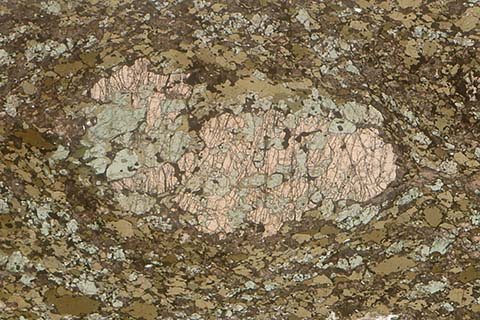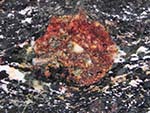Garnet-bearing amphibolites from the metamorphic sole
Abstract (Cowan et al., 2014, Geol. Soc. London, Spec. Publ. 392):
Two localities where the inverted metamorphic sole of the Oman Ophiolite are best exposed,
Sumeini Window and Wadi Tayyin, have been mapped and sampled in greater detail. In both
areas an inverted pressure and temperature profile is exposed beneath the Semail thrust,
the base of the ophiolite, from garnet+clinopyroxene-bearing granulite to hornblende+plagioclase
amphibolite down through epidote amphibolite and a variety of greenschist facies metasediments,
dominantly cherts, marbles and quartzites. Thermobarometry on garnet- and clinopyroxene-bearing
amphibolites immediately beneath the contact with mantle sequence harzburgites shows that
the upper sole rocks formed at PT conditions of 770-900°C and 11-13 kbar, equivalent to depths
of 30-40 km in oceanic lithosphere. Heat for metamorphism can only have been derived from the
overlying mantle sequence peridotites. Pressures are higher than can be accounted for by the
thickness of the ophiolite (15-20 km). Timing of peak metamorphism was synchronous with
formation of the ophiolite gabbroic–trondhjemite crustal sequence and eruption of the
pillow lavas (Cenomanian; 96-95 Ma). Metamorphic sole rocks have been structurally repeated
by imbricate thrusting, casting doubt on previous estimates of thermal gradients. All the data
support a subduction zone setting for metamorphism and a supra-subduction zone environment for
ophiolite formation during the Cenomanian.
The crucial insight here is that the association of garnet with clinopyroxene (+/- plagioclase) represents relics of a well-annealed high-pressure granulite-facies assemblage that pre-dates the strong fabric development and all or most of the hornblende. Glimpses of the original textural relationships are occasionally preserved in cm-sized oval porphyroclastic enclaves. Thermobarometry on the amphibole-free assemblage confirms the high pressures (~12 kbar). Hydration and shearing at slightly lower recorded P and T marks the beginning of exhumation from the hot subduction channel. The mechanism of exhumation is still a matter of debate.
For a petrographic tour of the high-T sole microstructures see the Oman metamorphic sole photo album on the OESIS site (opens in a new window/tab).

Partly digested oval enclave of garnet-clinopyroxene granulite in specimen OM62, Sumeini window, Oman

